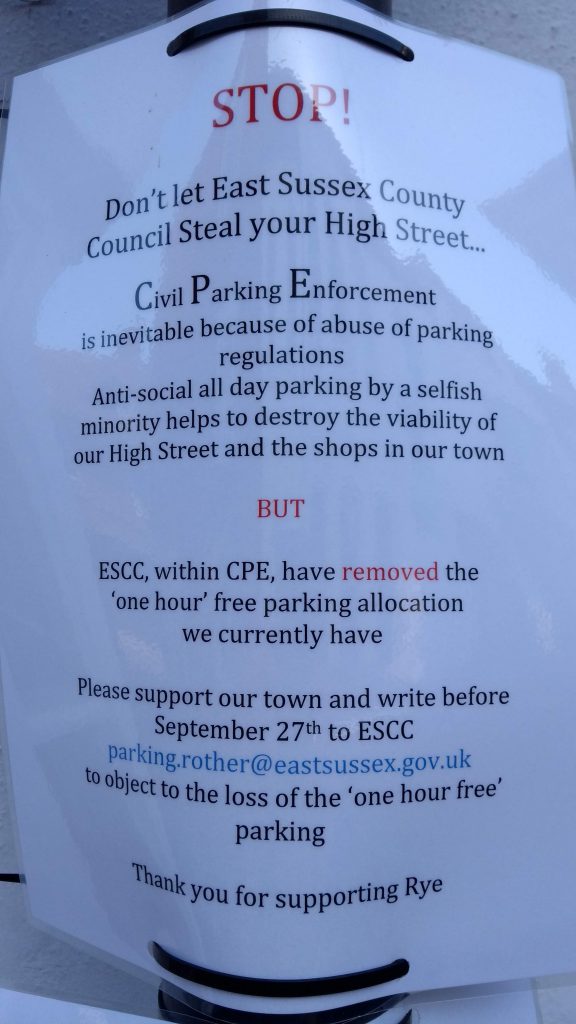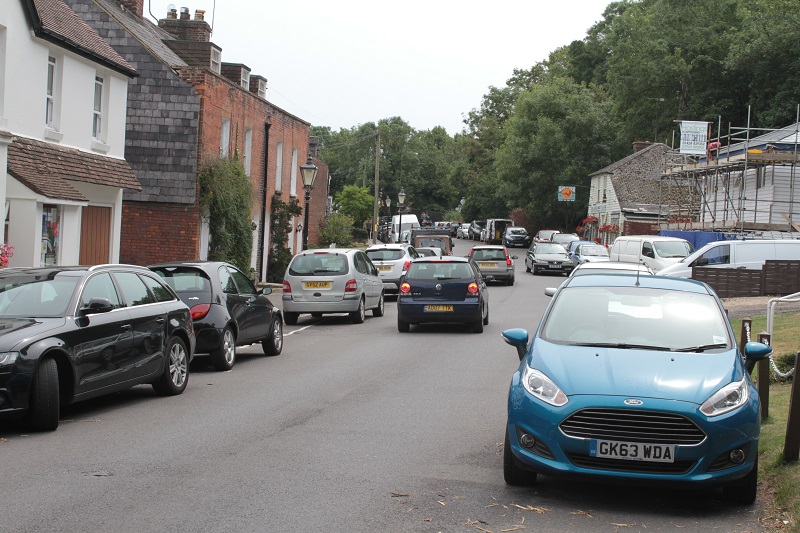Last week we reported on the debate by Rye Town Council on the pros and cons of civil parking enforcement (CPE) and have since received the views of a number of our readers, many of whom are not clear on what the town council can and cannot control (and, indeed, why should they be?). This is an attempt, therefore, to put the parking discussion into context.
Prior to the local government reorganisation in 1973, towns such as Rye had considerable autonomy and were responsible to the county council. However at that time someone in the Ted Heath government decided it would be a great idea to insert another layer of local government between the parishes and towns and the county council. This new layer, the district councils, grouped together villages and towns within a given area and brought them under one single administration.

Some larger towns (eg Hastings) are large enough to be their own ‘district’, but Rye, along with Battle and number of villages was absorbed into the district we now know as Rother and much of the power and decision-making of the town council was also taken over by the new Rother District Council. Rye could now advise and recommend, but its ability to take its own decisions was considerably reduced.
So how does parking fit into this?
Traffic management used to be the province of the police. Rye had a large and fully-manned police station, there were bobbies and PCSOs on the street who would issue tickets and fines where appropriate, thus keeping traffic movements and parking under reasonable control. However, cutbacks on both manpower and budgets resulted in local policing becoming almost non-existent and, in addition, the police pointed out that the administration of parking control (patrolling, issuing tickets, collecting fines, chasing non/late payers) was roughly equivalent in cost to the fine that had been levied but which the police were not allowed to keep to cover their costs. The inevitable result, of course, was that they could no longer afford for their duties to include parking, and it is now a rare sight to see a bobby on the beat, let alone ticketing illegally parked cars, in our town.
The town council have been wrestling with this problem for some time. One proposed scheme – which came so close to being adopted – was to share a warden with Battle and operating out of police premises (for which the police would be paid). This, we understand, met with general agreement with all parties except the police and crime commissioner and the chief constable who turned it down, flat.
For Rye to employ its own warden and deal with the consequent administration is, it seems, not financially viable, quite apart from the fact that it still might not get the approval of all the other interested authorities.
Finally, the possibility of CPE arose. Operated at county council level this would have to be a district-wide scheme (i.e. the whole of Rother). It would not take into account car parks but just on-road parking.
This looked to be a solution and although it took Rother DC a long time to come round to the idea, it was finally formally proposed and Rye Town Council agreed to it ‘in principle’ only, while waiting for the fine details of how it would operate.

At one of the council meetings, the town was warned to ‘be careful what you wish for’ and this has turned out to be prophetic now that the full details are known.
CPE turns out to be a one-size-fits-all cure, and the same arrangements that are suitable for a large town, such as Bexhill, are deemed also to be suitable for Rye. No account has been taken or, we are told, will be taken when the scheme starts, of Rye’s special circumstances – narrow roads and pavements, the latter obstructed with large ticket machines, seasonal influx of tourists, need for short-term free parking to help the high street, lack of easily accessible car parks and the problem of vehicles displaced from the town centre causing problems and inconvenience elsewhere.
On the question of the removal of the current one-hour free parking, Chamber of Commerce spokesman, David Nixon comments: “Tenterden, our nearest competitor town, operates a ‘Code 30’ CPE scheme that gives the ‘one hour free’ entitlement, in this way its borough council is in line with many local authorities trying to encourage footfall to our high streets, a problem that is recognised nationally. This type of scheme would work well in Rye and is closely aligned to what we have currently. We would ask the public to support our town by going online at consultation.eastsussex.gov.uk
The county councillor for Rye has suggested that the scheme could be reviewed after a year or so to see how it was working. Once in place, however, one has to wonder what the chances would be of it ever being changed regardless of local opinion at that time. (Rye News put a question to Rye County Councillor Keith Glazier on Deadmans Lane and the problems there, some months ago, but no answer has yet been received, despite a reminder. One suspects that suggested modifications to CPE could meet the same fate).

There has been a mandatory public consultation over the last few weeks which ends on Friday, September 27 (the day you may be reading this) and it is in response to this that the town council has passed a motion stating that they no longer agree to CPE in Rye. They are not able to opt out the town unilaterally and find an alternative. The only hope of a satisfactory conclusion to this – and it is a hope that is slim, almost to the point of non-existence – is that the county council will recognise the problem and enter into serious discussion with the town council to adjust CPE so that it works for Rye. This will also mean taking account of those roads which, under the currently proposed arrangement would be outside the CPE area but adversely affected by it.
Image Credits: Kevin McCarthy , Rye News library .




Important to note that CPE is about enforcement of regulations on existing roads where they apply. Wider traffic and parking impacts fall outside any scheme and are covered in the (now agreed) Neighbourhood Plan. A new working group is waiting for a call to action by Rye Town Council to consider, in parallel with CPE, the issues raised in the Plan.
The parking free-for-all that is the citidel has reached a point where I welcome the introduction of CPE so that illegal and inconsiderate parking will be curbed. The opportunity for an alternative has gone. So accept CPE and work to ensure a proper review is undertaken at the end of the first year and have workable proposals for alternatives ready.
Exactly!
The alternative to CPE is still here until decriminalised – the police. It remains their responsibility which they refuse to undertake. ESCC put forward no alternative proposal apart from the one they have just finished consulting on, yet they were able to apply to the Department for Transport with details of their scheme before the consultation had even started or comments being considered. This highlights that no meaningful consultation ever took place. Rye Town Council have withdrawn support for the ESCC scheme and it is unlikely that ESCC will listen to any comments in a review.